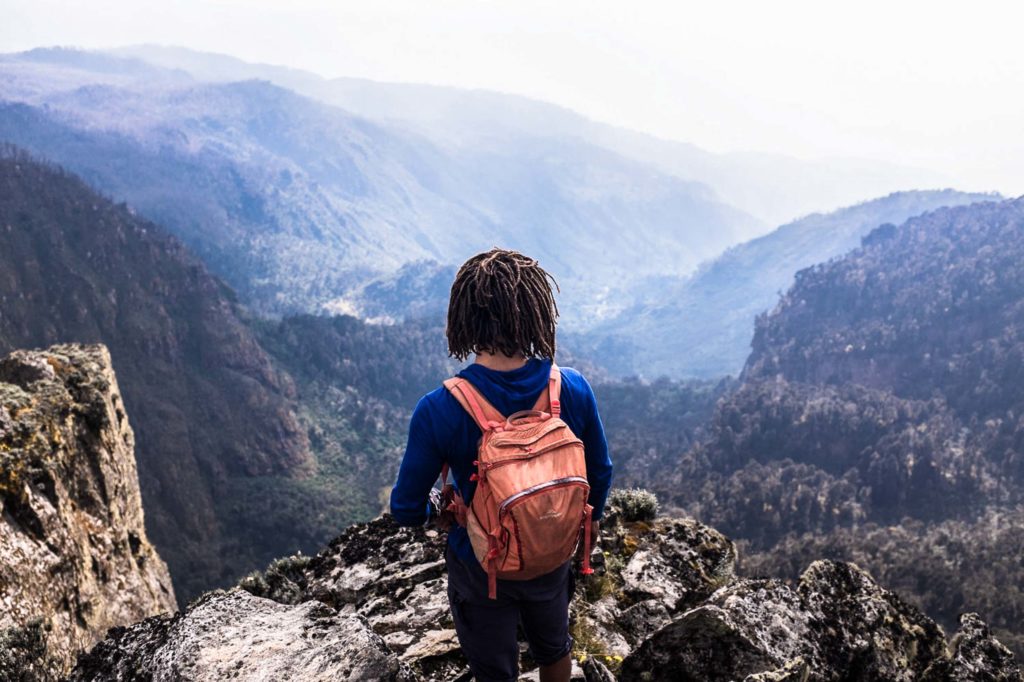Prince John Apollo Rwamparo, Second Deputy Prime Minister of the Bunyoro-Kitara Kingdom, expressed deep concern over the recent demolition of Haibale rock in Kigorobya sub-county, Hoima district, Western Uganda.
This significant rock formation fell victim to the extraction of aggregate stones during the construction of a 110-kilometre Hoima-Buliisa-Wanseko road, aimed at facilitating oil production.
Haibale rock holds a unique connection to the historical and renowned Kibiro hot spring, which is believed to source its hot water from this very rock.
In Graam Connah’s Memoir 13 at the British Institute in Eastern Africa, it is described as an impressive natural feature, nestled on the southeastern shore of Lake Albert, at the foot of the Western Rift Valley.
Despite its cultural and ecological importance, Haibale rock faces the peril of siltation and encroachment, and its destruction could lead to the extinction of the hot springs, jeopardising salt mining activities.

Haibale rock in Kigorobya Sub-County in Hoima district. Photo: Robert Atuhairwe/The Albertine Journal.
Rwamparo, who also serves as the kingdom’s tourism minister, recognised the paramount need to safeguard Haibale rock to protect Bunyoro’s cultural heritage, support educational efforts, conduct historical research, and preserve a sense of identity.
The plight of Haibale is not an isolated case, as many other Sacred Natural Sites (SNS) around East Africa face the dual threat of development and environmental degradation.
SNS such as mountains, hills, forests, groves, trees, rivers, lakes, lagoons, caves, islands and springs dating back centuries are natural features having special spiritual and cultural significance to surrounding communities.
They are also ecologically sensitive-habitats to wild animals, insects, and birds and are places where locals get herbs due to rare plants replete there.
Their destruction has resulted into loss of biodiversity, loss of plant pollinators and consequently reduced food and increased ecosystem disorder and resulted in adverse climate changes.
For example, the destruction of Rwenzori Mountains has affected the tangible and intangible cultural heritage which provides a landscape that defines the identity of Bakonzo people and a home to their traditional beliefs.
Bakonzo who are one among the Bantu speaking occupants on Rwenzori Mountains are now worried about the wanton human activity on the mountain’s ecology, traced to the 1950s when foreign firms started mining copper.
The extracted soil was used to claim part of the Nyamwamba river valley. This changed its natural course to pave the way for Kilembe, one of Uganda’s towns in the 1960s.
A recent report says up to 15 million tonnes of waste was used to create artificial hills and directed the river but, with glacier melt and unpredictable rainfall, the force of unprecedented volumes of water leads the river to regain its original course and burst its banks.
In February 2012, fires in the mountains also cleared much of the vegetation that helps to control the rivers as they flow downstream.
The fires which occurred during a dry season due to poaching affected the steep areas, until rains later controlled them.
Efforts to restore these sites and mitigate the impact of their destruction are critical.
Conservationists like Sylvester Kule Walyuba stress the need for long-term regeneration, projecting that it will take more than two decades for vegetation to recover from fire-induced damage.
Seven years after the fires, devastating floods occurred in the Rwenzori region in 2013, these suddenly returned in 2020.

Rwenzori Mountains. Net Photo.
Five rivers (Nyamwamba, Mubuku, Lhuburiba, Nyamughasani and Sebwe) burst their banks, affecting much of Kasese district.
The flooding river carried huge rocks, resulting in cumulative debris deposition in the valleys.
The floods razed almost the entire Kilembe town, destroyed 15 schools, swept away homes and farms, cut off bridges, and shattered domestic water supply systems, protected springs and water treatment plants.
Some SNS have been completely washed away, while others such as the hot springs, have been submerged and silted.
According to Uganda Wildlife Authority, the government body that manages the Rwenzori Mountains National Park, the mountains have up to 20 lakes that supply and sustain several rivers.
The lakes are created as a result of the continuously receding snows, which a 2020 UNESCO study projects will disappear completely in the next two to three decades.
“If this happens, the Bakonzo will have lost some of their cultural roots and their water-based heritage sites,” the report adds.
The Bakonzo interpret the snow as a frozen sperm of Kithasamba, who carries out fertilisation of earth and their society by the yearly snowmelt, which sustains the rivers flowing down the mountains.
The river confluences and waterfalls are treated with reverence as they habour Ndokya, the water spirit.
Whenever there are calamities such as floods, drought or famine, the Bakonzo carry out a ritual cleansing of the ridges and rivers, usually ending at a confluence where a ritual broom is thrown into the water.
The locals feel the rising temperatures is a sign of anger by Kithasamba, the father of the spirits, due to severe degradation of nature caused by population growth and desecration of the mountains.
Similarly, Loita forest within Narok County in Kenya in the Masai community has seen agriculture and building taking over biodiversity conservation.
Mining of chilly Quartzites is another serious threat to the biodiversity of the forest as it destroys large chunks of land and medicinal plants.
Sacred natural sites like Mount Olkaria on the floor of the rift valley in Kenya are equally threatened by large scale energy power projects.
From Zanzibar, Tanzania, Burundi and Rwanda they are fast diminishing and their immediate territories such as forests, wetlands, mountains, hills, rivers and lakes.
A 2021 World Bank report highlights that approximately 41% of Uganda’s land is degraded, and the 2022 report from Uganda’s Ministry of Water and Environment projects a drastic reduction of wetland cover to only 1.6% by 2040. Uganda has witnessed a significant loss of 23% of its forest cover from 2000 to 2020.
In response to these alarming developments, the African Commission on Human and People’s Rights (ACHPR) passed Resolution 372 during its 60th ordinary session in Niamey, Niger on May 8 to 22, 2017.
This resolution acknowledged the growing impact of environmentally damaging industrial activities and infrastructure development on SNS and territories. It called upon governments to enact laws, policies, and measures to safeguard these sacred sites.
Recognising the urgency of the situation, ecologists and cultural experts from various African regions convened in Hoima city and Buliisa district in Western Uganda on May 17 to 18, 2023.
Organised by the African Institute for Culture and Ecology (AFRICE), the meeting aimed to discuss strategies for the conservation of these sites.
AFRICE, with funding from the African Biodiversity Network and the Swedish Government, is embarking on a three-year project in Buliisa to revive and strengthen Bagungu customary governance systems, raise awareness about the importance of safeguarding and restoring ecosystem resilience, and educate local communities about eco-friendly farming practices.
Indigenous communities, such as the Bagungu in Bunyoro kingdom, have traditional attachments to specific sacred sites within their regions.

Locals are sensitised to appreciate the importance of safeguarding and restoring ecosystem resilience and integrity of sacred natural sites. Photo: Robert Atuhairwe/TAJ.
Denis Tabaro Natukunda, the Executive Director of AFRICE and an earth jurisprudence practitioner, highlighted the challenges they faced in mobilising custodians of these sites, whose traditions had been marginalised by Western culture.
Nonetheless, they have successfully mapped and documented 33 sacred sites, identifying functional custodians and their respective custodial clans and ancestral structures.
In 2021, AFRICE provided support for the drafting of an ordinance that was eventually passed by the Buliisa district council, aimed at recognising and conserving sacred natural sites as places of spiritual, cultural, and ecological significance.
This initiative includes the collection of indigenous seeds by women to be blessed at these sacred sites, fostering traditional agro-ecology and traditional seed conservation to ensure food security.
Protecting sacred natural sites not only conserves the environment but also preserves cultural traditions and practices.
This approach has significantly reduced environmental degradation, helping to combat food loss and mitigate climate change, particularly in ecologically sensitive areas such as wetlands.
In Kenya, Eunice Nkopio with Mainyoito Pastoralists Integrated Development Organisation (MPIDO), said they have secured land tenure to ensure that the Naimina Enkiyoyo forest remains community-owned and protected.
In addition to land tenure, they have strengthened traditional systems responsible for biodiversity conservation, including the council of elders.
Combating poverty and enhancing climate change resilience are also crucial elements of protecting these sites.

Eunice Nkopio. Photo: Robert Atuhairwe/The Albertine Journal.
Dr. Sulemana Abudulai, Chairman of the African Biodiversity Network Board of Trustees, called on governments to enact protective legislation that designates these sites as protected areas, enforces strict regulations against destructive activities, and establishes penalties for violators of conservation laws.
Moreover, it is vital to involve local communities and indigenous peoples, including custodian clans and guardians of sacred natural sites, in decision-making processes related to the management and conservation of these sites.
“Respecting their traditional knowledge, practices, and rights is essential for effective conservation efforts and promoting sustainable development that aligns with their cultural values,” Abudulai added.
The recent meeting also emphasised the importance of capacity building within communities for cultural conservation and ecological knowledge.
Sharing best practices, strengthening networking and partnerships among stakeholders, advocating for increased resources, and implementing sustainable solutions were key takeaways from the event.

Women collect indigenous seeds to take to the custodians which they (custodians) take to the sites for blessings. Photo: Robert Atuhairwe/The Albertine Journal.
Aliguma Ahabyona Akiiki, the Programme/Communications Coordinator of Cross-Cultural Foundation of Uganda (CCFU), an organisation which promotes the recognition of culture, said appropriating sacred natural sites is a violation of human rights and leads to the loss of connection with their identity.
“The region is losing a resource into cultural tourism which is more sustainable than any other form of tourism because it rhymes well with the people and is a big contributor to earnings from tourism,” he told The Albertine Journal.


A captivating read!
Your article provides insights that challenge the status quo. Thank you for the fresh perspective!